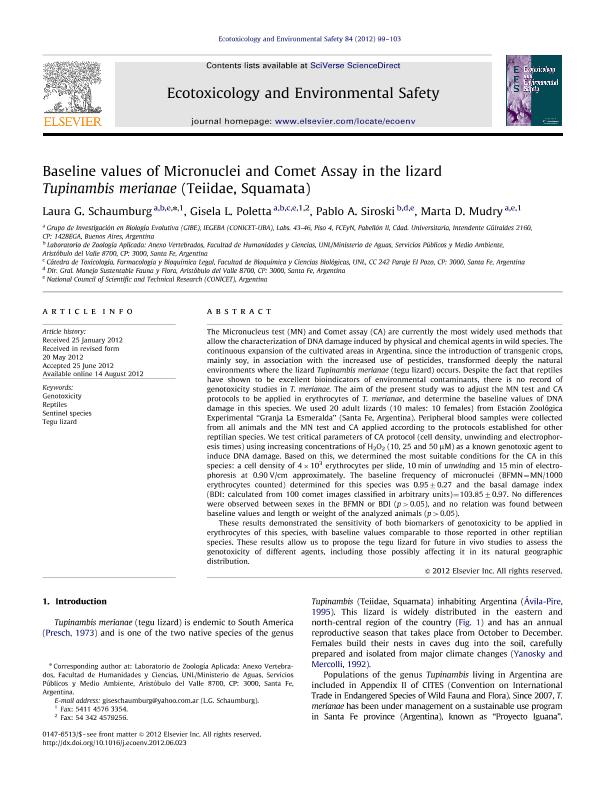Mostrar el registro sencillo del ítem
dc.contributor.author
Schaumburg, Laura Gisela

dc.contributor.author
Poletta, Gisela Laura

dc.contributor.author
Siroski, Pablo Ariel

dc.contributor.author
Mudry, Marta Dolores

dc.date.available
2023-06-05T16:14:49Z
dc.date.issued
2012-10
dc.identifier.citation
Schaumburg, Laura Gisela; Poletta, Gisela Laura; Siroski, Pablo Ariel; Mudry, Marta Dolores; Baseline values of Micronuclei and Comet Assay in the lizard Tupinambis merianae (Teiidae, Squamata); Academic Press Inc Elsevier Science; Ecotoxicology and Environmental Safety; 84; 10-2012; 99-103
dc.identifier.issn
0147-6513
dc.identifier.uri
http://hdl.handle.net/11336/199578
dc.description.abstract
The Micronucleus test (MN) and Comet assay (CA) are currently the most widely used methods that allow the characterization of DNA damage induced by physical and chemical agents in wild species. The continuous expansion of the cultivated areas in Argentina, since the introduction of transgenic crops, mainly soy, in association with the increased use of pesticides, transformed deeply the natural environments where the lizard Tupinambis merianae occurs. Despite reptiles have shown to be excellent bioindicators of environmental contaminants, there is no record of genotoxicity studies in T. merianae. The aim of the present study was to adjust the MN test and CA protocols to be applied in erythrocytes of T. merianae, and determine the baseline values of DNA damage in this species. We used 20 adult lizards (10 males: 10 females) from Estación Zoológica Experimental “Granja La Esmeralda" (Santa Fe, Argentina). Peripheral blood samples were collected from all animals and the MN test and CA applied according to the protocols established for other reptilian species. We test critical parameters of CA protocol (cell density, unwinding and electrophoresis times) using increasing concentrations of H2O2 (10, 25 and 50 µM) as a known genotoxic agent to induce DNA damage. Based on this, we determined the most suitable conditions for the CA in this species: a cell density of 4 x 103 erythrocytes per slide, 10 min of unwinding and 15 min of electrophoresis at 0.90 V/cm approximately. The baseline frequency of micronuclei (BFMN= MN/1000 erythrocytescounted) determined for this species was 0.95 ± 0.27 and the basal damage index (BDI: calculated from 100 comet images classified in arbitrary units) = 103.85 ± 0.97. No differences were observed between sexes in the BFMN or BDI (p > 0.05), and no relation was found between baseline values and length or weight of the analyzed animals (p > 0.05). These results demonstrated the sensitivity of both biomarkers of genotoxicity to be applied in erythrocytes of this species, with baseline values comparable to those reported in other reptilian species. These results allow us to propose the tegu lizard for future in vivo studies to assess the genotoxicity of different agents, including those possibly affecting it in its natural geographic distribution.
dc.format
application/pdf
dc.language.iso
eng
dc.publisher
Academic Press Inc Elsevier Science

dc.rights
info:eu-repo/semantics/openAccess
dc.rights.uri
https://creativecommons.org/licenses/by-nc-sa/2.5/ar/
dc.subject
GENOTOXICITY
dc.subject
REPTILES
dc.subject
SENTINEL SPECIES
dc.subject
TEGU LIZARD
dc.subject.classification
Otras Ciencias Biológicas

dc.subject.classification
Ciencias Biológicas

dc.subject.classification
CIENCIAS NATURALES Y EXACTAS

dc.title
Baseline values of Micronuclei and Comet Assay in the lizard Tupinambis merianae (Teiidae, Squamata)
dc.type
info:eu-repo/semantics/article
dc.type
info:ar-repo/semantics/artículo
dc.type
info:eu-repo/semantics/publishedVersion
dc.date.updated
2023-06-05T11:58:04Z
dc.journal.volume
84
dc.journal.pagination
99-103
dc.journal.pais
Estados Unidos

dc.description.fil
Fil: Schaumburg, Laura Gisela. Consejo Nacional de Investigaciones Científicas y Técnicas. Oficina de Coordinación Administrativa Ciudad Universitaria. Instituto de Ecología, Genética y Evolución de Buenos Aires. Universidad de Buenos Aires. Facultad de Ciencias Exactas y Naturales. Instituto de Ecología, Genética y Evolución de Buenos Aires; Argentina
dc.description.fil
Fil: Poletta, Gisela Laura. Consejo Nacional de Investigaciones Científicas y Técnicas. Oficina de Coordinación Administrativa Ciudad Universitaria. Instituto de Ecología, Genética y Evolución de Buenos Aires. Universidad de Buenos Aires. Facultad de Ciencias Exactas y Naturales. Instituto de Ecología, Genética y Evolución de Buenos Aires; Argentina
dc.description.fil
Fil: Siroski, Pablo Ariel. Consejo Nacional de Investigaciones Científicas y Técnicas; Argentina. Universidad Nacional del Litoral. Facultad de Humanidades y Ciencias. Departamento de Ciencias Naturales. Laboratorio de Zoología Aplicada: Anexo Vertebrados (FHUC-UNL/MASPyMA); Argentina
dc.description.fil
Fil: Mudry, Marta Dolores. Consejo Nacional de Investigaciones Científicas y Técnicas. Oficina de Coordinación Administrativa Ciudad Universitaria. Instituto de Ecología, Genética y Evolución de Buenos Aires. Universidad de Buenos Aires. Facultad de Ciencias Exactas y Naturales. Instituto de Ecología, Genética y Evolución de Buenos Aires; Argentina
dc.journal.title
Ecotoxicology and Environmental Safety

dc.relation.alternativeid
info:eu-repo/semantics/altIdentifier/url/https://www.sciencedirect.com/science/article/pii/S0147651312002187
dc.relation.alternativeid
info:eu-repo/semantics/altIdentifier/doi/http://dx.doi.org/10.1016/j.ecoenv.2012.06.023
Archivos asociados
